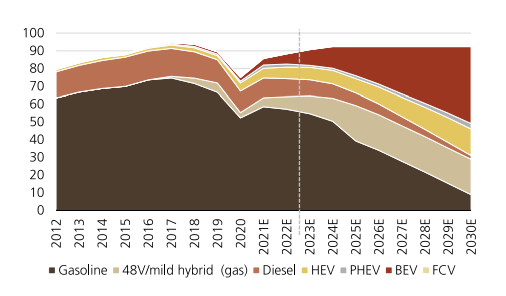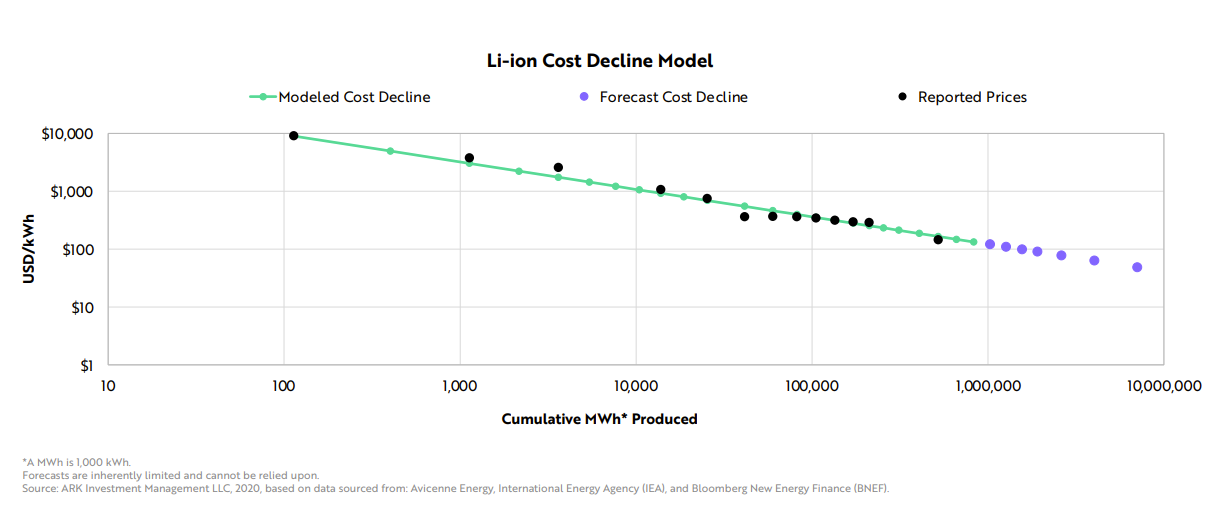Over the past decade, the way we travel has continued to grow. Today, there are more than one billion cars on the road. This exponential growth is difficult to sustain for the planet in the long term.
The health crisis of 2020 acted as an electroshock for many consumers. During lockdowns, mobility was reduced by half and solutions such as bicycles became real alternatives in the city. However, the car, the ultimate symbol of freedom and autonomy, is here to stay. Our thematic list focuses on this sector, even though mobility affects many more areas than land transport.
The players of the old automotive world are looking for solutions to become more eco-friendly. Among underlying trends, we find the emergence of electric cars (BEV) over the last decade. According to a recent June 2021 report by UBS, the deployment of electrification is expected to grow exponentially rather than linearly. This movement has recently gained momentum since 2019 with the arrival of new competitors and the release of new vehicle models. While electric vehicles are not a silver bullet, potential improvements in manufacturing methods and battery components will likely reduce the pollution impact of these means of transportation.
The electrification of the world's vehicle fleet is expected to continue its rapid growth and account for 70% of vehicles in service by 2030. Widespread electrification will be necessary to achieve the European Union's goal of zero net carbon emissions by 2050.
All vehicle manufacturers will have to do so sooner or later. The leaders in the sector are already monopolizing market share, but the synergy between the brands will be an additional strength for major groups to catch up.
Evolution of the distribution of vehicle engines over time:

HEV: Hybrid vehicles - PHEV: Plug-in hybrid vehicles - BEV: Electric vehicles - FCV: Fuel cell vehicles
Source: Berenberg
For electric (and hybrid) cars to be accessible to all, the cost of batteries must of course be reduced. According to Wright's Law, for each cumulative doubling of units produced, the cost of battery cells will decrease by 28%. The battery is the most important cost element of an EV. This cost reduction is therefore essential to achieve price parity with gasoline-powered vehicles.
Wright's Law models the potential decline in battery costs in the future:

Source: Ark Investment
Autonomous vehicles are also gaining momentum. They promise to reduce the number of serious accidents and improve traffic flow through inter-vehicle communication. By 2030, 79% of vehicles sold worldwide will have a level 2 or higher autonomy. The entire urban network and infrastructure can benefit from this trend.
Our team has compiled a thematic list of companies actively participating in the transformation of the industrial and commercial landscape of tomorrow's mobility, whether they are car, truck or bus manufacturers, suppliers to the sector, car-sharing companies, battery manufacturers or manufacturers of intelligent infrastructures. Cleaner, more reasonable, better thought-out mobility. The players on this list could benefit from this long-term trend.

 By
By 


















